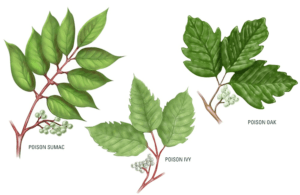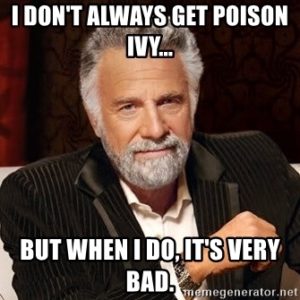Common Poisonous Plants in Central Texas
The list of poisonous plants in Central Texas is long and wide-reaching. We want to be careful about how we write about this for obvious reasons. So here is my disclaimer… be careful around poisonous stuff. But, we get frustrated when we see the common poisonous plant lists because the inference of each of these lists is that you should stay completely away. Many of these plants are common, native plants (meaning you see them on the side of the street and in the woods all over Central Texas).
The Classic Poisonous Plants in Central Texas (these are some of the ones you really should avoid):
If you are anything like me, you get confused about the differences between all of the most obviously poisonous plants in Central Texas: Poison Ivy, Poison Sumac, and Poison Oak. Just remember to stay away from all of them…

Poison Sumac:
Poison Sumac is much more of a shrub or even tree than its two evil friends. It can grow between 5 and 20 feet tall and typically has 7-10 leaves on each stock. It is generally considered to be more allergenic than poison oak or poison ivy. Just like poison ivy, it has a red stock. The leaves turn orangish in the fall and then drop. Even the fallen leaves are dangerous. In fact, smoke from poison sumac leaves and wood is very dangerous to breathe.
Interestingly, we have read that the chemical structure of Tapatio hot sauce is a great remedy to relieve the itching, so just add one or two drops to the area when in contact. (Just kidding – please don’t put any hot sauce on your body).
Poison Oak:
Very similar to its counterpart, poison ivy, this plant will cause a rash when brought into contact with your body. Also similarly, it will always have a three-leaf structure s and will have wavy or scalloped edges.

Often times they appear to be a glossy green color, but depending on the season they can be yellow, red, or brown. The stem typically has a greyish color and is covered in thorn-like structures.
To slow the itching down be sure to wash with cold water and use lotions such as calamine lotion directly to the site. It also helps if you do a handstand and draw an elephant.
Nearly 15% of Americans are not allergic to poison oak, so if you’re one of the few, congratulations. This reading was not a waste of your time, seeing that you can now help the other 85% of Americans who are waging the war against poisonous leaves.
Poison Ivy:
“When leaves are in groups of THREE, careful you should BE.” Poison ivy, like poison oak grows in groups of three leaves. It can grow in almost any Texas climate. Leaves are red in the spring before they turn green and when the plant starts to die back in the fall and winter the leaves turn yellow. You should be very careful burning this plant, as the toxicity can travel in the smoke and cause serious respiratory issues.
Some of the common, “less-dangerous” plants.
Caution- the following statement is a reflection of worldview 🙂
Just because something is dangerous, doesn’t mean that we should completely avoid it. In fact, many of the best things in life (experiences, relationships, financial gains, etc) come with risk, danger, and difficulty. We are not telling you to put poisonous plants in your yard and chew on them first thing every morning, but we also want to acknowledge that some of the plants on the poisonous plant lists aren’t really all that bad. We are sure some of these can still really hurt you, but we feel comfortable putting them into our own yards: Lantana, Sago Palms and Nandina. There are even lists out there that include Mountain Laurels, Bermuda Grass (half the manicured turf out there), and Oaks (half the hardwoods in Central Texas).
If you want to learn more about our team, please visit our team page here.
If you think we have bad poisonous plants in Central Texas, check out this crazy garden in England. Instead of an herb garden, they chose to grow a “Poison Garden”. They claim that every plant in the garden can kill you.
